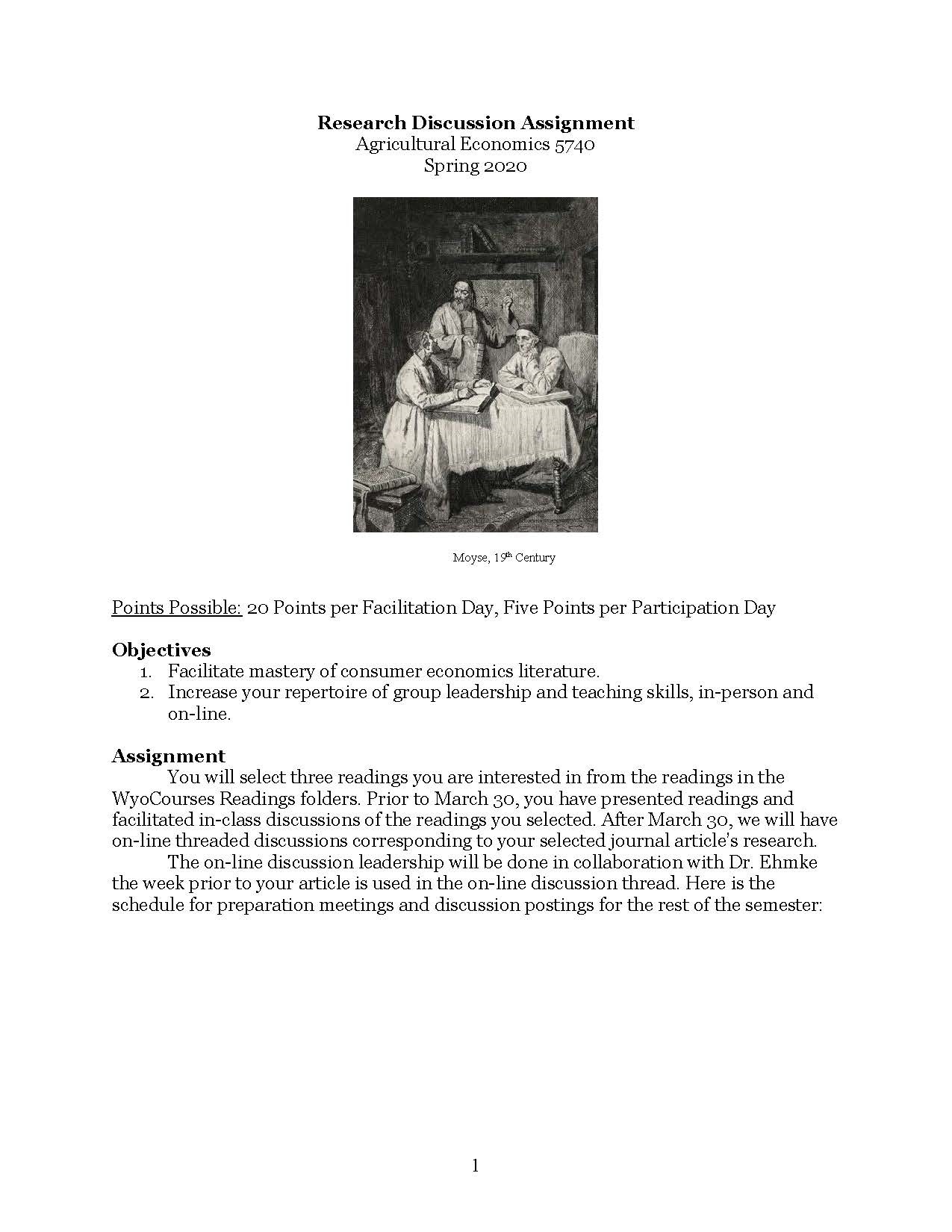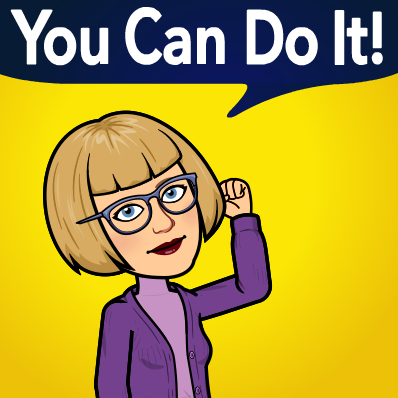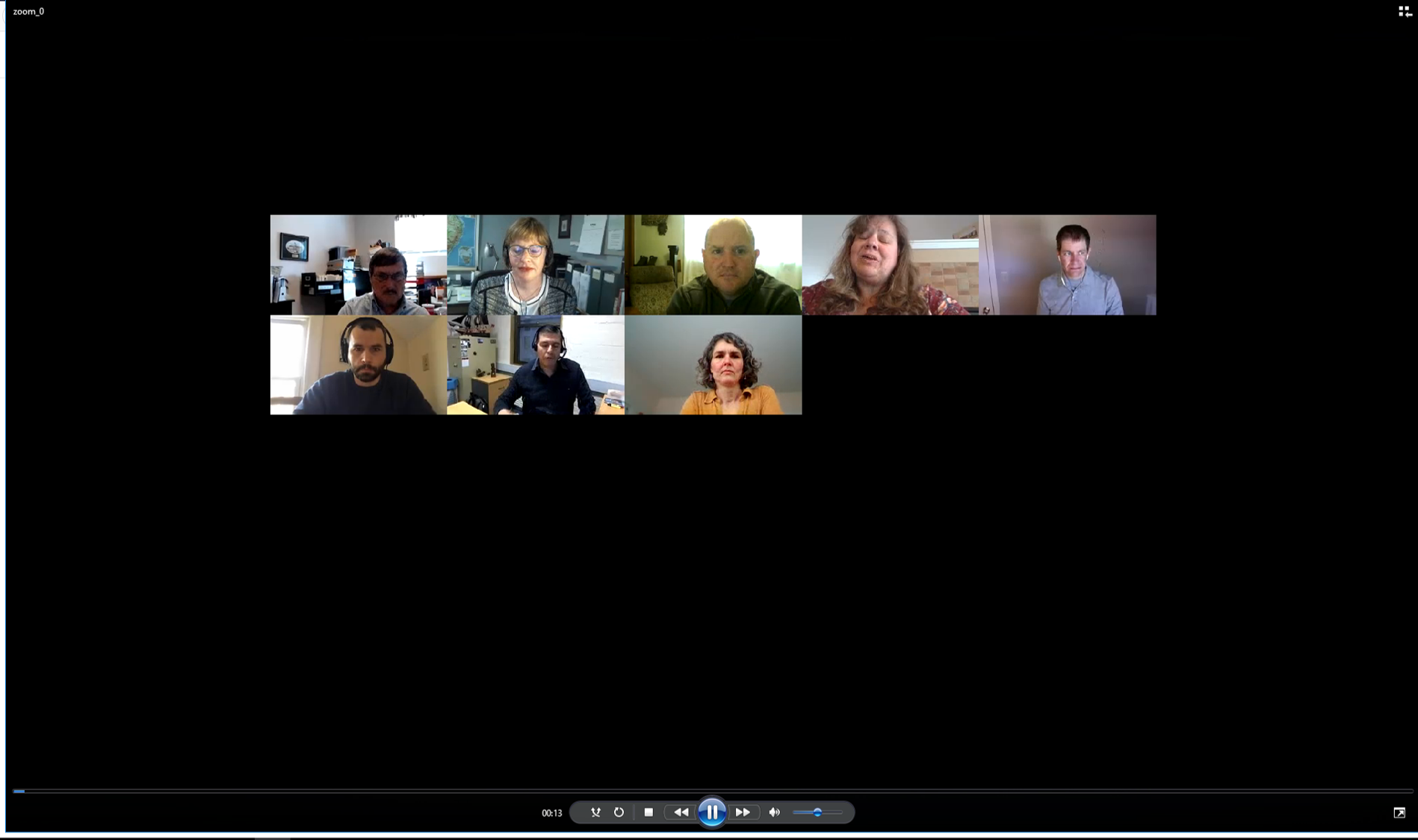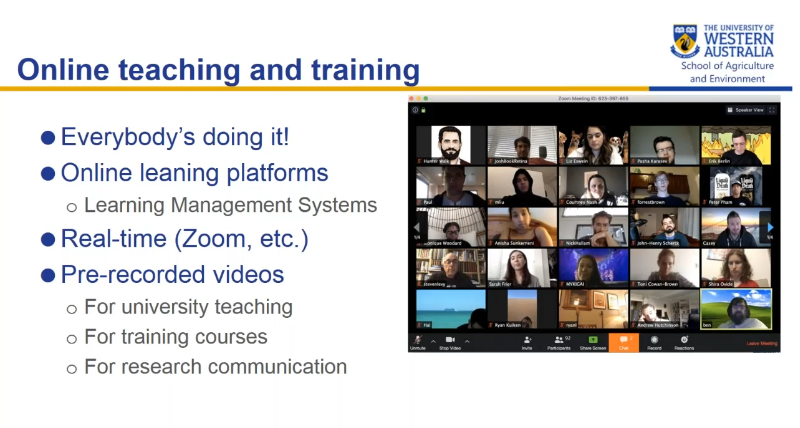Online Learning and Teaching Resources
Welcome to the AAEA Online Learning and Teaching Resources Portal. The portal was developed in response to the rapid shift to remote learning and teaching to promote social distancing and health during these times. Based on an AAEA survey, this portal provides resources, guidance, advice, materials and links to promote online learning and teaching in our discipline. All material is accessible to the public and AAEA members. In addition, we encourage and ask instructors and AAEA members to submit recorded lectures, online videos, case studies, online active learning exercises, notes, advice, links and other material to help other instructors and further populate this portal.
Announcements
The Teaching, Learning, and Communication Section is resuming their Virtual Teaching Conversations on the last Friday of every month this Spring:
First Meeting: Friday, January 29: 1 pm PST (3 pm CST and 4 pm EST); last meeting: Friday, May 28: 1 pm PST (3 pm CST and 4 pm EST).
These meetings are envisioned as informal conversations during which we discuss teaching challenges and share our experiences. Each meeting will start out with a specific teaching challenge, innovation, or the presentation of ongoing pedagogy research but we leave ample time for participants to ask questions and discuss challenges on the spot. You can join us via the following Zoom link (Meeting ID: 96494430834; Password: Teaching). For additional comments or questions please contact Kristin Kiesel or Julianne Treme.
TLC Track sessions:
Evaluating Teaching: A Holistic Approach to Evaluating Scholarship of Teaching (joint with CWAE Section)
Meeting Recording: https://arizona.zoom.us/rec/share/
tP5rJbbP6zlLX7Oc7xv2R6IxLInVeaa81SYa_PtcykcmoE8JJpCMdylGUopWUS4l
The Impact of Stress and Emotion on Decision Making (joint with EXECON Section)
View the entire session now: https://calpoly.zoom.us/rec/share
/4_VxAKDtpnxLGJ3O8E3vHe0MQZi8X6a8hnUdrKdYnxsWBYbikAIutSvCjZJfvX6N
Innovations in Teaching Environmental and Resource Economics (joint with ENV Section)
View the entire session now on YouTube: www.youtube.com/watch?v=XF9ONMsdPqw
Teaching Tips from AAEA Award Winners and Panel Discussion on Transitioning to a New Online Environment—Lessons Learned (joint with GSS)
View the entire track session now on YouTube: https://www.youtube.com/watch?v=aiu61XqU7dc
AETR Call for Papers: Online/Remote Learning and Teaching Special Issue
Applied Economic Teaching Resources is doing a special issue of the publication on innovations, teaching strategies and issue related and involving online and remote learning and teaching. Topics include but are not limited to pedagogy, case studies, online learning activities, online assessment, preparation for transitioning to online and remote teaching, the impact of COVID-19 on learning and teaching, and other pertinent topics. In addition, we encourage commentary submissions from academics and researchers on their “real-time” learning outcomes in this environment. That is, the learning outcomes and hard lessons learned of what to do and what not to do that could be useful to the readers of AETR going into the future.
Please submit articles as soon as possible for readers to benefit. All submissions will go through a expedited review and be posted in the Advanced Access for readers as soon as possible after submission. Final submission date is September 1, 2020.
Applied Economics and Teaching Resources is calling for manuscripts on teaching methods, curriculum development, and programs to foster diversity and inclusion in agribusiness and agricultural economics classrooms and departments. Click on the above link for more information. Manuscripts will be accepted through December 31, 2021. Special Issue Editors: Dr. Mariah Ehmke, University of Wyoming (mariah.ehmke@uwyo.edu), and Dr. Kenrett Jefferson Moore, North Carolina A & T University (jykenret@ncat.edu).
General Instructional Resources and Practice
Getting Started
Successfully providing remote learning opportunities begins with setting realistic expectations and making plan. Best practices include:
- Set clear objectives of what you want students to learn (Expect to cover less material than in an in-person class).
- Think about how you can ensure access and engagement with students (Provide various options to access the material; do not be afraid of rapidly prototyping).
- Practice patience and flexibility (Donot expect perfection, communicate often that we are all learning together).
Note: You are not expected to create an integrated, pedagogically sound, online course right off the bat. You are trying to find a way to deliver your content remotely in this unusual situation. Focus on building trust with students that you will find ways to support their learning and assess them fairly.
Online Lecturing
There are a number of great resources created and shared over the past couple of weeks regarding technology aspects of online learning already. To be able to navigate these resources and make decisions about synchronous engagement (e.g. real-time or live Zoom meetings) as well as asynchronous materials (e.g. pre-recorded videos), begin by reflecting on what you usually do in an in-person lecture on a goal-oriented level (e.g. presentation of content, checking for understanding, reflection exercises— instead of just saying lecture, quiz, discussion). With those in mind and based on your own comfort level, consider the following continuously evolving recommendations:
- Teach lectures live when you can (and provide video recordings).
|
Live lectures (Synchronous Teaching) |
Recorded videos (Asynchronous Teaching) |
|
Advantages:
Disadvantages:
|
Advantages:
Disadvantages:
|
- Provide pre-recorded content in short videos (no longer than 10 to 15 minutes), or break up longer content by inserting questions or other ways of engagement (e.g. quizzes, reflections, interactive exercises).
- Make sure to explain as clearly as you can and in a variety of ways independent of your delivery method (e.g. what students can expect; what students are responsible for; where to find materials; what to do first; how they can communicate with you).
Online Assessment
Evaluating student learning progress can be challenging in a remote learning environment, and often requires different strategies and tools than traditional in-class exams and quizzes. Some suggestions included:
- Provide more frequent “low stakes” assessment to incentivize students to keep coming back your course material and reduce incentives for integrity violation attempts.
- Provide very detailed instructions for each assessment activity, preferably in more than one format (in a separate assignment explanation document as well as embedded in the assignment itself, for example).
- Be more “flexible” with regard to completion times and options than you would in a in-person class in consideration of connectivity, technology, and (especially in unexpected online class conversion situations) to mitigate the increased stress issues.
- Use individually created project assignments, discussion boards with required contributions, or student submitted video’s where students are required to incorporate concepts from class material instead of standard question type assessments.
- When using traditional question type assessments consider utilizing tools that randomly draw individual questions for each student from a larger question bank (randomly draw 10 questions from a bank of 30 for example), randomly change the order of questions for each student, and for multiple choice questions randomize the answers for each individual question in order to reduce opportunities for cheating.
AETR Article: Assessing Student Learning Using a Digital Grading Platform
Andrew W. Stevens, Mississippi State University
Link: https://www.aaea.org/UserFiles/file/AETR_2019_003ProofFinal_pages_v2.pdf
AETR Article: Personalizing Online Classes: The Use of Evaluation and Participation Tools
Luis Peña-Lévano, University of Florida
Link: https://www.aaea.org/UserFiles/file/AETR_2020_031ProofFinal_v1.pdf
AETR Article: No Honor Among Cheaters: A “Prisoner’s Dilemma” Approach to Reduce Cheating in Online Classes
Jeffery S. Young, Murray State University
Link: https://www.aaea.org/UserFiles/file/AETR_2020_007ProofFinal_v1.pdf
Communicating with Students
You and your students will be more excited about on-line education with visual, oral, and emotional enrichment. Here are a few recommendations to enrich your connection with students:
 Visual enhancements may bring students into a topic like photographs appeal to readers in magazines or newspapers. On-line, they may be employed in discussions prompts, assignment headers, and even your syllabus! In the example below, a classical drawing is used to inspire on-line, threaded research discussions (see image to right):
Visual enhancements may bring students into a topic like photographs appeal to readers in magazines or newspapers. On-line, they may be employed in discussions prompts, assignment headers, and even your syllabus! In the example below, a classical drawing is used to inspire on-line, threaded research discussions (see image to right):
- You have an opportunity to connect with students through your voice and theirs. Be sure to ask the students to prepare for meetings with something to report. If you do not have any synchronous meetings scheduled, as them to upload videos to share with each other or you for comment and discussion. In large classes, these can be done within groups.
- Find ways to for you and your students to use a sense of humor. There are many ways you can do this including cartoon strips, your own emoji cartoons, (clean) jokes, and fun tik tok videos. Did you know the FAO has an educational and fun TikTok channel? See a timely video here.

Student Support
Suddenly, on-campus students find themselves in a cyber world. Here are a few things you can do to help them cope.
- Work with your colleagues to create or advance a virtual learning community beyond your course. Make sure all students have an opportunity to connect with other students in their cohort. Keep advising lines open. The sense of community and support may reduce student anxiety and help them navigate cyber classrooms.
- Offer synchronous or real-time meeting opportunities. You may record lectures and move discussions to discussion boards, but also make sure students have an opportunity to talk to you and know you are listening on an on-line program (e.g., Zoom) or the telephone. Social media may be used with caution. Not all students feel comfortable with programs such as Facebook. Research shows varying success with social networking aps.
- Be compassionate. As students were pushed out of their campus learning environment, many will experience more stress and decreased psychological well-being. They may have job and new family dynamics to work out in addition to studying. To aid in this adjustment, make sure they have information about university counseling services and share free stress-management resources. Here are a few to pass along:
- COVID-19 Mental Health Tips from the University of Wyoming
- Mindfulness and stress reduction exercises such as this from the Mayo Clinic or these from Harvard University Center for Wellness and Health Promotion
General Resource Links
- Teaching Online (Oklahoma State University):
https://itle.okstate.edu/TeachOnline.vbhtml?utm_source=OSU+Communications&utm_campaign=b3f3c2011a-EMAIL_CAMPAIGN_2020_02_27_10_27_COPY_01&utm_medium=email&utm_term=0_ef85cdae6a-b3f3c2011a-20598901
- Keep Teaching Strategies and Resources (University of California, Davis):
https://keepteaching.ucdavis.edu/
Online Teaching Materials by Subject Matter
This section provides resources to help assist with online teaching and learning that are organized by specific disciplinary subjects within Agricultural, Applied Economics and Agribusiness. Materials include links to videos, downloadable exercises, case studies, and other useful material.
Copyright and Attribution: Please appropriately provide attribution for all materials used to the source and/or author. All original material posted to the web site will fall under a Creative Commons (CC) License to provide authors and submitters to grant copyright permissions for their creative work. Three primary licenses types are specified:
- CC BY – This license lets users distribute, remix, adapt, and build upon the work, even commercially, but credit must be given to the author of the original work.
- CC BY-SA – This license lets users remix, adapt, and build upon the work, even for commercial purposes, but credit must be given to the author of the original work and derivatives of this work must be licenses as CC BY-SA.
- CC BY-NC-SA - This license lets users remix, adapt, and build upon the work, but not for commercial purposes. Credit must be given to the author of the original work and derivatives of this work must be licenses as CC BY-NC-SA.
For further information, please visit https://creativecommons.org/licenses/.
General Topics
 Covid-19 Impacts in Agriculture, Food and Nutrition
Covid-19 Impacts in Agriculture, Food and Nutrition
Will Masters, Tufts University
Description: Short slide deck for teaching, updated 9 April 2020. The link to the slides can be found by selecting the Access Materials button. Copyright License: CC BY
 Webinar About Online Teaching and Creating Videos
Webinar About Online Teaching and Creating Videos
David Pannell, University of Western Australia
Description: I recently gave a webinar for the Australasian Agricultural and Resource Economics Society on "Online teaching and video production". A link to the full recording of the webinar can be found by selecting the Access Materials button. Copyright License: CC BY
Broadway Economics
Matthew Rousu, Susquehanna University
Description: This website contains over 60 songs that teach economics using show tunes. The songs cover many areas in applied economics, and you can browse through songs or search (e.g., demand, elasticity). The link to the material can be found by selecting the Access Materials button. Copyright License: CC BY.
AETR Article: Enhancing Student Engagement in a Changing Academic Environment-Tested Innovations for Traditional Classes and Online Teaching
Kristin Kiesel et al.
Link: https://www.aaea.org/UserFiles/file/AETR_2019_034ProofFinal_v5.pdf
Technology Requirement Letter
Tomas Nilsson, Olds College, Alberta, Canada
Description: College instructors provide information to first-year students on technology requirements and recommendations. Feel free to use whatever is relevant to your institution. The recommendations are heavily influenced from participants at the AAEA TLC webinar.
Copyright Agreement: CC BY
Introductory and Principles of Agricultural Economics and Economics
AETR Article: The Do Now: A Simple, but Effective Active Learning Strategy
LaPorchia A. Collins, Tulane University
Link: https://www.aaea.org/UserFiles/file/AETR_2019_021ProofFinal_v2.pdf
Agribusiness and Food Marketing
 The Agricultural Marketing System
The Agricultural Marketing System
Joe Parcell, University of Missouri
Description: Free e-access to textbook and instructor materials on the agricultural market system.
AETR Article: Using Data Analytics and Decision-Making Tools for Agribusiness Education
Matthew S. Elliott and Lisa M. Elliott, South Dakota State University
Link: https://www.aaea.org/UserFiles/file/AETR_2019_026ProofFinal_v1.pdf
 Growing a Niche Market: Revisiting A Targeted Marketing Plan for Colorado Homestead Ranches
Growing a Niche Market: Revisiting A Targeted Marketing Plan for Colorado Homestead Ranches
Dawn Thilmany, Colorado State University
Description: This is a case study that focuses on consumer segmentation by a local beef collaborative, but a new teaching note is added to provide questions that may add relevance in the time of COVID-related shifts in food purchases. Licensing Option: CC BY-NC-SA
AETR Link: Teaching Competition Topics: Applications of Seller Market Power in Agricultural Industries
Yuliya V. Bolotova, Clemson University
Link: https://ageconsearch.umn.edu/record/300072?ln=en
 Short Case Study and Teaching Materials: Citrus Wars
Short Case Study and Teaching Materials: Citrus Wars
Kristin Kiesel, University of California - Davis
Description: The uploaded short case study and additional teaching materials (videos) used for discussions in sections can easily be adapted to create online assignments as well as scenario questions for exams. Copyright Licensing: CC BY
The Economic Impact of COVID-19 on U.S. Food Manufacturers
Dawn Thilmany, Colorado State University
Description: This was a webinar invited by an industry partner, but could be used for any course trying to cover current events in the food supply chain. Discussion questions and slides are provided. Link to webinar and documents are accessible by selecting the Access materials button. Copyright: 2020 CC BY-NC-SA.
 Senior-Level “Prices” Online Quizzes and Practice Questions for Two Lecture Topics: “Price Determination in Market Structures with Seller Market Power: Theory and Applications” and “Price Determination in Market Structures with Buyer Market Power: Theory and Applications”
Senior-Level “Prices” Online Quizzes and Practice Questions for Two Lecture Topics: “Price Determination in Market Structures with Seller Market Power: Theory and Applications” and “Price Determination in Market Structures with Buyer Market Power: Theory and Applications”
Yuliya Bolotova, Clemson University
Description: The teaching and assessment materials include two Canvas-based quizzes and practice questions structured using a multiple-choice format, which were developed for two lecture topics on price determination processes in markets with different structures in a senior level “Prices” course. Selected questions were also used in a junior level “Agribusiness Management” course and in a junior level “Economics of Agricultural Marketing” course. The questions related to both the theory and applications are tied to the economic models of seller market power (monopoly and oligopoly) and economic models of buyer market power (monopsony and oligopsony) explained in standard microeconomics textbooks. Materials are accessible by selecting the Access materials button. Copyright: 2020 CC BY-NC-SA.
 Senior Level “Prices” Online Exam on Empirical Demand and Price Analysis
Senior Level “Prices” Online Exam on Empirical Demand and Price Analysis
Yuliya Bolotova, Clemson University
This exam is a Canvas-based midterm exam in a senior level “Prices” course. The exam covers several topics on empirical demand and price analysis, which are explained in standard textbooks in the areas of managerial economics and agricultural markets and prices. The exam answers are structured using a multiple-choice format. The answer key is provided. The exam questions can be incorporated as lecture (in-class) examples, in-class assignments and homework questions. To access the materials please click the Access Materials button.
Copyright License: CC BY-NC-SA
 Discussing Food Supply Chain Challenges in the COVID19 Pandemic
Discussing Food Supply Chain Challenges in the COVID19 Pandemic
Darren Hudson, Texas Tech University
Description: This short video highlights the role of food supply chains and some of the challenges facing the food industry. It discusses the parallel supply chains for retail and food service and issues of moving food between chains. The video also discusses issues of risks in integrated supply chains, livestock markets, and farm labor related. Presents a good overview for lower-level students to relates issues of supply chains to a real world problem. The link to the video can be obtained by clicking on the Access Materials button.
Copyright License: CC BY.
 Senior Level “Prices” Research Project: “Price-Quantity Relationship and Profitability in the U.S. Peanut Industry.”
Senior Level “Prices” Research Project: “Price-Quantity Relationship and Profitability in the U.S. Peanut Industry.”
Yuliya Bolotova, Clemson University
Description: The research project objective is to apply the inverse demand framework to analyze the price-quantity relationship and profitability in the U.S. peanut industry. This is a take-home research project. It includes an empirical price analysis, which involves estimating a price-dependent demand function for peanuts at the farm-gate level, and an analytical analysis of four market scenarios differing due to the peanut quality produced, peanut price and the industry profitability. These market scenarios are a peanut over-supply scenario, a perfectly competitive industry scenario, a small degree of the seller market power scenario, and a hypothetical monopoly. The answer key is provided. Please click the “Access Materials” button to download the materials.
Copyright License: CC BY-NC-SA.
 Mini Outlook Report
Mini Outlook Report
Author: Ana Claudia Sant’Anna, West Virginia University
Description: An exercise to guide students on how to write an outlook report. It has two steps to guide students on how to collect, analyze and organized information. The goal is to prepare students on how to write a report and then share that information in a synthesized manner, in this case online. The exercise focuses on the impacts of COVID-19 on the economy. After analyzing the information, students are to provide predictions/assessments on how this may impact agricultural lending (i.e. impacts on farm debt or to lenders). Students had knowledge on financial measures, lending practices, risk management, investment analysis, etc.
Copyright Licensing: CC-BY-NC-SA.
Farm and Ranch Management, Production Economics
AETR Article: Even Robots Need a House: The Robotic Milking System Facility Investment Decision Case Study
Ryan Feuz and Ryan Larsen, Utah State University
Link: https://ageconsearch.umn.edu/record/301864/files/AETR_2019_028ProofFinal_v5.pdf
AETR Article: Red Stick Farm: Planning for the Future
Maria Bampasidou and Whitney R. McKinzie, Louisiana State University
Link: https://ageconsearch.umn.edu/record/301865/files/AETR_2019_029ProofFinal_v5.pdf
Junior Level Agricultural Finance Mid Term Exam – Online Version
 Rodney Jones, Oklahoma State University
Rodney Jones, Oklahoma State University
Description: An Example of an individual project assessment tool to replace a traditional exam when the course was moved to and online environment. Designed to maximize individual creativity and reduced cheating, while capturing the concepts covered in this section of the class. Under License CC BY.
Environmental and Natural Resource Economics
View the entire session now on YouTube: www.youtube.com/watch?v=XF9ONMsdPqw
International Trade, Development, and Marketing
EconoNutrition: Using Economics and Nutrition to Address Global Undernutrition and the Dietary Transition 
William Masters, Tufts University
Description: Lecture on global undernutrition and the dietary transition, for the University of California Network on Child Health, Poverty and Public Policy's 2019 summer school. The link to slides, video materials, and other materials can be found by selecting the Access Materials button. Copyright License: CC BY
Cost and Affordability of Nutritious Diets 
William Masters, Tufts University
Description: Video of seminar for the DFID economics department, 30 Mar. 2020, from Will Masters (Tufts University). The link to slides, video, papers and other materials can be found by selecting the Access Materials button. Copyright License: CC BY
Agricultural Policy
AETR Article: On the “Government Cheese: A Case Study of Price Supports”
Katherine Lacy, Todd Sørensen and Eric Gibbons, University of Nevada, Reno and The Ohio State University at Marion
Link: https://ageconsearch.umn.edu/record/301862/files/AETR_2019_14ManuscriptProofFinal_v4.pdf
EconoNutrition: Using Economics and Nutrition to Address Global Undernutrition and the Dietary Transition 
William Masters, Tufts University
Description: Lecture on global undernutrition and the dietary transition, for the University of California Network on Child Health, Poverty and Public Policy's 2019 summer school. The link to slides, video materials, and other materials can be found by selecting the Access Materials button. Copyright License: CC BY
Cost and Affordability of Nutritious Diets 
William Masters, Tufts University
Description: Video of seminar for the DFID economics department, 30 Mar. 2020, from Will Masters (Tufts University). The link to slides, video, papers and other materials can be found by selecting the Access Materials button. Copyright License: CC BY
AETR Article: Interacting with Agricultural Policy 280 Characters at a Time: Twitter in the Classroom
Julianne Treme, North Carolina State University
Link: https://www.aaea.org/UserFiles/file/AETR_2019_032ProofFinal.pdf
Statistics, Econometrics and Data Tools










 AAEA On-Line Teaching Resources and Best Practices Webinar
AAEA On-Line Teaching Resources and Best Practices Webinar


 A Personalized Take-Home Exam for Introductory Economics
A Personalized Take-Home Exam for Introductory Economics